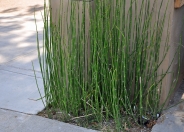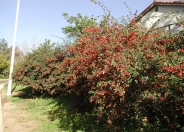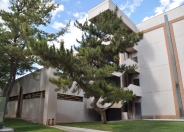
Common name: Horsetail
Botanical name: Equisetum hyemale
This reed-like plant has dark green, jointed stems that reach 3'-4' tall but will spread. It should receive sun to part shade with regular summer watering. The reed grass can be extremely invasive and is best when used in pots or when confined by a barrier. However, it can be extremely effective as an accent plant. While tolerant of wet conditions, the most successful plantings are those with regular watering and more during summer. It does well in coastal areas. Tall grasses are highly combustible.

Common name: Red Clusterberry Cotoneaster
Botanical name: Cotoneaster lacteus parneyi
This is an evergreen shrub that grows to a size of 8' tall and 12' wide, with long, arching branches. Cotoneaster exhibits dark green leaves above and gray beneath. Small white flowers bloom in spring. During fall and winter, round red fruit appear. It does best in full sun as this shrub will stay more compact. However, it will grow in complete shade but may be leggy. This plant is tough enough to reseed and naturalize in many areas in CA, and should be considered potentially invasive. In other areas, it is used as a screen. It is drought tolerant once it's established.

Common name: Japanese Aralia
Botanical name: Fatsia japonica
This evergreen shrub has large, glossy, fan-like leaves that grow to 16" wide. It has a moderate growth rate to a size of 5'-8' tall and wide that can be kept lower with occasional pruning. It has a very lush, tropical appearance, and grows well in partial shade. During winter, white flowers appear followed by black berries. Looks great in containers or in shade gardens or even as a houseplant near window with good lighting. This shrub does best with moist, acidic, well draining, fertile soil. It does not tolerate full sun or wind. When established, it will tolerate drought and urban pollution.

Common name: Japanese Black Pine
Botanical name: Pinus thunbergii
This variety of Pine is both rigid and twisted, with needles of 3"-4". It has an irregular shape, and the short, contorted branches produce a canopy shaped tree. The buds are white, and the cones are egg -shaped and without prickles. Pines are highly combustible plants.